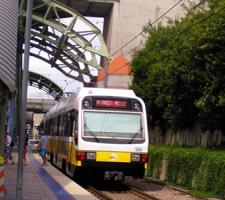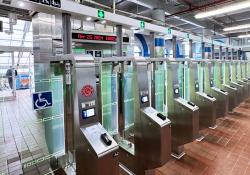
David Crawford explores passenger and operator benefits of on-board Wi-Fi
Urban commuters’ growing demand for continuous – and reliable - internet connectivity is spurring network operators into the rapid installation of high-grade Wi-Fi access on their surface and underground networks, as well as in their stations. Such moves are often a key part of strategies to maintain and increase ridership levels.
Laurent Dauby, the
Operating companies can also benefit from being able to:
- Deliver such passenger-oriented services as part of wider, often safety-related, communications projects that they need to undertake; and
- Harvest passengers’ use of social media via Wi-Fi as a valuable data source for plugging gaps in their travel information services, as well as for monitoring reactions to network performance and being able to take remedial steps.
A recent report from the Paris-based New Cities Foundation (NCF) shows the Middle East and North Africa (MENA)**, Asia/Pacific, and European regions as being well advanced in the deployment of Wi-Fi connectivity on their urban rail networks – notably ahead of both North and Latin America. Its survey used an online mapping tool to study the situation in 48 systems (a third of the global total) in 28 countries. Between them, these carry nearly two thirds of world metro ridership.
NCF has developed the tool in partnership with the UITP, Swedish communications giant
In what Naureen Kabir, director of NCF’s applied research arm, the Urban (co)LAB, claims as “the first comprehensive survey,” results show that more than three quarters of networks surveyed offer a degree of internet access, either in stations (73%) or on-board trains (58%). The proportion offering both is 55%.
While Wi-Fi can be quickly and easily provided in stations, the foundation points out, it is more challenging to install on trains because of the need for base stations at close intervals along the track to support uninterrupted connectivity.
Looking ahead, the NCF survey found that 68% of operators plan to increase the level of broadband access in existing stations between now and 2017. Currently 60% of metros already offer connectivity at all their stations and the NCF expect that in future, most new stations will be designed with Wi-Fi from the outset.
In a cautionary note, however, the foundation stresses that, since the quality of Wi-Fi connections are a function of the numbers of users logging on at any one time, usage restrictions may be necessary. Currently, 60% of metros impose these, and the NCF expects a “slight increase” in this proportion over the coming years.
It also points out that “too generous internet access can be undesirable.” This can encourage travellers to loiter in stations and hamper rapid passenger boarding at the expense of the fluidity of crowd movement needed “especially during rush hours.”
New developments
With North America lying relatively low on the world metro Wi-Fi take-up list, two recent developments are particularly timely. Last month San Francisco-based
In the same month, the
In developing Cisco’s package, global transportation executive Barry Einsig told ITS International that communications for safety was the top priority (US statistics report that human error accounts for almost two-thirds of all rail-related accidents). “We have layered our other applications on top of this.”
The system is designed to enable passengers to keep their mobile devices connected to a single Wi-Fi network from arriving at the station and throughout the train journey until they reach their destination. They will also be able to access service information through interactive, on-station platform signs that are fed with real-time information derived from the monitoring of passenger movements.
Einsig sees the result as “a new platform for powerful analytics that can be used to deliver new passenger services and improve the traffic flows. It can deliver a new experience for passengers; they can rely on getting more enjoyment out of their journey, or being easily able to work during it.”
Clients for the system include the San Francisco Municipal Transportation Agency, Dallas Area Rapid Transit and, in Europe, the UK’s track infrastructure company
Developed by Chicago-based InMotion Wireless, MBTA’s commuter rail Wi-Fi system is destined to benefit from a high-speed radio network running 640km along the track right-of-way, from where it will beam into train cars on 14 commuter services. The go-ahead for this followed the US Federal Communications Commission awarding the company a nationwide 3.6 GHz wireless licence. The system will also serve the MBTA network’s three main commuter interchanges with the city’s metro system, at South, North and Back Bay stations; as well as ferry links with communities across Boston Harbour.
On completion, company founder Dimitrios Lalos told ITS International, passengers will enjoy a free basic service and a premium alternative that will allow them to stream data and video. The MBTA will receive 7.5% of subscriber revenues.
Lalos says that the system will have no upfront costs, and be funded by paid-for advertising targeted at passengers on the basis of their location. He instances local community events and supermarkets wanting to make area- and period-specific offers as likely sources of customised promotion.
He also plans travel apps and live TV broadcasts from a local TV station, which will share ad revenues. On the way, too, are a social media channel dedicated to commuters and a ‘Tshare’ car- and taxi- rideshare.
Passengers as data sources
Meanwhile, harvesting and analysing passengers’ use of social media via Wi-Fi is creating business for new companies such as Europe-based Transport API, which has some 400 app developers working to utilise its travel information platform. Its recently-introduced Transport Buzz product sweeps for travellers’ opinions and geolocates these on a screen map for operators’ and other passengers’ reference, using a cursor. It is searchable by key words such as “strike.”Results range from genuinely helpful information, such as “Uber is the greatest taxi app ever”, to less than complimentary expressions of opinion. Indeed Transport API warns that tweets – in any language (translations not offered) – are not censored.
But even the more robust comments can potentially have value thanks to the emergence of sentiment mapping technology. This involves the deeper analysis of social media traffic in order to evaluate – and make use of - the passenger’s strength of feeling on a travel problem. Start-up company Commonplace uses crowdsourcing-based technology (developed by Open City Labs) to encourage citizen-centred involvement in designing and using the built environment, to score passengers’ comments - at the most basic level in terms of positive or negative quality.
It envisages transport operators using the results to give additional depth and colour to their use of real-time travel information resources in helping to speed up journey times. It could also, Commonplace founder Mike Saunders told ITS International, make possible wider and more finely detailed public consultation on planned major transport infrastructure projects. He said he is close to signing off a deal with a major US city which is looking to use the system as the basis for replanning its transport strategy.
So it seems the provision of Wi-Fi is a win-win situation for passengers and transit authorities alike.
*UITP defines a metro as an urban rail system that is 100% segregated from other traffic, running underground, on viaducts or at grade (within fencing).
** While the MENA region came top for Wi-Fi availability, it had only two networks that were surveyed, and both of them are recent.








